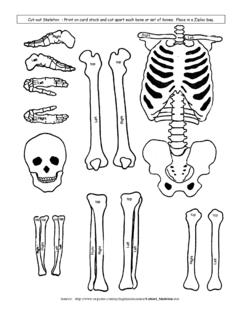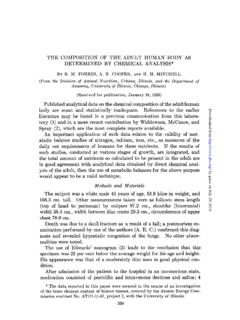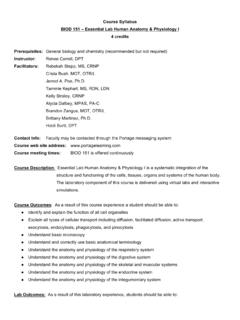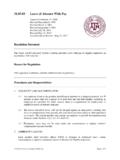Transcription of The place of Homo floresiensis in human evolution
1 Doi JASs Proceeding Paper Journal of Anthropological Sciences Vol. 94 (2016), pp. 5-18. The place of homo floresiensis in human evolution Karen L. Baab Department of Anatomy, Midwestern University, Arizona College of Osteopathic Medicine 19555 N. 59 th Av., Glendale, AZ 85308. e-mail: Summary - Two main evolutionary scenarios have been proposed to explain the presence of the small- bodied and small-brained homo floresiensis species on the remote Indonesian island of Flores in the Late Pleistocene. According to these two scenarios, H. floresiensis was a dwarfed descendent of H. erectus or a late-surviving remnant of a older lineage, perhaps descended from H. habilis. Each scenario has interesting and important implications for hominin biogeography, body size evolution , brain evolution and morphological convergences. Careful evaluation reveals that only a small number of characters support each of these scenarios uniquely.
2 H. floresiensis exhibits a cranial shape and many cranial characters that appear to be shared derived traits with H. erectus, but postcranial traits are more primitive and resemble those of early homo or even australopiths. Mandibular and dental traits show a mix of derived and primitive features. Unfortunately, many traits cannot be used to assess these two hypotheses because their distribution in H. erectus, early homo ( , H. habilis), or both is unknown. H. erectus ancestry implies evolutionary convergence on a postcranial configuration similar to australopiths and early homo , which could be explained by a return to more climbing behaviors. Body size reduction as well as brain size reduction on a scale only rarely documented in mammals would also accompany the origin of H. floresiensis from a H. erectus ancestor. H. habilis ancestry implies parallel evolution of numerous cranial characters, as well as a few dentognathic traits.
3 A pre-H. erectus ancestry also suggests an early migration to Southeast Asia that is as yet undocumented in mainland Asia, but minimal body and brain size reduction. Keywords - homo floresiensis , Evolutionary history, Hominin morphology, Convergence, Biogeography. Introduction modern H. sapiens are known throughout the Old World. The authors of the 2004 announcement of Although H. floresiensis is undoubtedly an a new hominin species, homo floresiensis , on the evolutionary side branch without direct rel- Indonesian island of Flores suggested that: The evance for the evolution of H. sapiens, a better first hominin immigrants may have had a similar understanding of the evolution of H. floresiensis body size to H. erectus and early homo , with sub- has important implications for hominin bioge- sequent dwarfing; or, an unknown small-bodied ography, evolutionary history and brain evolu- and small-brained hominin may have arrived tion.
4 I will discuss evidence from the cranium, on Flores from the Sunda Shelf (Brown et al., mandible, dentition, endocast and postcranial 2004, p. 1060). These two scenarios remain at skeleton as it pertains to each of these evolution - the forefront of evolutionary hypotheses seeking ary scenarios, and the implications of each sce- to explain the presence of small-bodied and phy- nario for the evolutionary history of this species. logenetically primitive hominins in this remote Non-evolutionary ( pathological ) explana- Southeast Asian locale during a time when tions have also been posited for LB1, but these the JASs is published by the Istituto Italiano di Antropologia 6 homo floresiensis in human evolution have not stood up to careful scrutiny. The pro- evidence of advanced cognition sometimes asso- posed diagnoses, including Laron syndrome, ciated with blade technology.
5 Archaeological sites cretinism, and Down syndrome share certain dated to Ma (Mata Menge; Morwood et clinical signs, including reduced stature and al., 1998) and Ma (Wolo Sege; Brumm et al., brain size, although in no case are the extremely 2010) from the Soa Basin of central Flores may be small stature, brain size and other anatomical the ancestral population for H. floresiensis , which features of the Liang Bua hominins ( , the would allow for ~1 Myr of evolution in isolation. interlimb proportions, thick cranial bones) com- The absence of hominin fossils from the Soa Basin patible with any of these pathologies ( , Falk precludes taxonomic identification of this popula- et al., 2009a; Brown, 2012; Baab et al., 2015). tion. Also nearby are numerous H. erectus sites on the western Indonesian island of Java ranging in age from to ~ or possibly Ma Background (Larick et al.)
6 , 2001; Hyodo et al., 2011; Indriati et al., 2011; Kaifu et al., 2011b). Liang Bua cave is a large cave located on Flores in eastern Indonesia. Flores is one of the islands of Wallacea, a region known for low levels of terres- Evolutionary hypotheses trial faunal diversity and high levels of island end- emism (van den Bergh et al., 2009). This pattern Perhaps the most notable characteristics of the is the result of strong isolation barriers between Liang Bua hominin assemblage are the small stature the regions of Wallacea and Sundaland / the Asian and small brain size that are apparent in the fairly mainland to the west, and Sahulland / Australia complete type specimen, LB1 (Brown et al., 2004). to the east. Even during the last glacial maximum Postcranial bones from other individuals are equally there was no land connection between Flores diminutive, if not a bit smaller ( , LB8) (Jungers and the islands to the west due to the deep straits et al.
7 , 2009b). Although only one cranium has been between Flores and Sumbawa, as well as between recovered from the Liang Bua site, two mandibles Bali and Lombok (Lambeck & Chappell, 2001). (from the LB1 and LB6 individuals) are very similar The hominin remains now assigned to H. flo- in morphology and size (Brown & Maeda, 2009). resiensis were recovered from Pleistocene deposits Evolutionary scenarios must explain the dated between ~18 and 74-95 ka (Brown et al., unique blend of anatomical features seen in the 2004; Morwood et al., 2004). Other terrestrial Liang Bua hominins. One hypothesis posits H. vertebrates recovered from these deposits include erectus as the ancestral population for H. flo- Stegodon, Komodo dragon, and smaller fauna, resiensis (Brown et al., 2004), with subsequent such as fish, frogs, snakes, rodents and bats. There island dwarfing.
8 Within this broader scenario, is taphonomic and archaeological evidence for different populations of H. erectus have been hunting or scavenging by H. floresiensis of young identified as being the likely stem population for stegodonts, Komodo dragons and other fauna the H. floresiensis lineage: early African H. erectus (Morwood et al., 2004; van den Bergh et al., ( , H. ergaster) ( , Gordon et al., 2008) and 2009). Lithic tools associated with H. floresiensis early Indonesian H. erectus (Kaifu et al., 2011a). are mostly simple pebble and flake tools, compa- A second hypothesis positions the divergence of rable to African Oldowan or Developed Oldowan the H. floresiensis branch before the origin of H. assemblages, but with a small number of seem- erectus, making the ancestor an early homo spe- ingly more sophisticated tools, such as blades cies such as H.
9 Habilis ( , Argue et al., 2009). (Morwood et al., 2004; Moore & Brumm, 2009). On the surface, discerning between these two Moore (2007) has suggested the few blades recov- alternatives should be a straightforward exercise. ered were incidental byproducts of the basic reduc- If the Liang Bua hominins present traits that tion sequence used by H. floresiensis rather than are derived for H. erectus compared to earlier Baab 7. hominins, then the likely evolutionary scenario despite being closer in overall size to these fos- is divergence from H. erectus. If the Liang Bua sils than most H. erectus specimens. LB1 par- hominins exhibit traits that are more primitive ticularly resembled the D2700 subadult from than those observed in H. erectus, then this would Dmanisi, but this is due in part to scaling pat- suggest a pre-H. erectus divergence. In either case terns wherein the diminutive LB1 resembled autapomorphic features likely reflect subsequent other small H.
10 Erectus. Thick cranial bones also evolution . In reality, the situation is unlikely to link LB1 to H. erectus but not earlier homo spe- be this clear cut. A quick survey of the literature cies. However, this must be viewed as relatively indicates a mix of primitive and derived traits weak support for H. erectus ancestry due to the as well as some unique features. This contribu- small sample sizes for early homo . Kaifu et al. tion has three goals. The first is to sort characters (2011a) compared character state distributions from the skull and postcranial skeleton into one of 67 craniofacial traits in LB1 and populations of three categories: of Plio-Pleistocene homo . They identified many traits in LB1 that appear to be derived for H. 1) those that are shared between H. floresiensis erectus relative to H. habilis (Tab. 1), including and H. erectus (or later homo species) to the some that were present in LB1 and early African exclusion of H.





